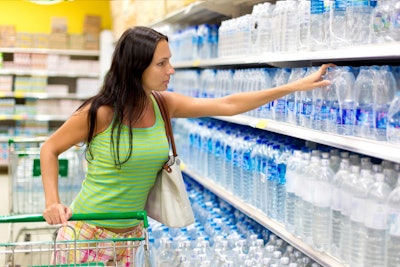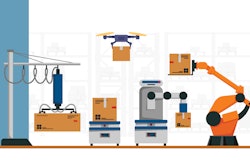Bottled water has been crowned America’s favorite bottled beverage, after reaching new peaks in both volume consumed and sales in 2022. That’s according to new data from the Beverage Marketing Corporation (BMC), which shows that bottled water’s total volume sold in 2022 was 15.9 billion gal, its highest volume ever, surpassing carbonated soft drinks for the seventh year in a row. In terms of retail dollars, 2022 sales approached $46 billion, up from $40.8 billion in 2021.
“Numerous qualities account for bottled water’s unceasing resonance with U.S. consumers, including its associations with healthfulness, convenience, safety, and value,” says John G. Rodwan, Jr., BMC’s editorial director. “Consumers’ thirst for beverages that offer benefits beyond refreshment alone also contributed to the fundamental hydrating beverage’s rise in the beverage standings. Bottled water’s zero-calorie status and its lack of artificial ingredients appeal to many consumers. Even where tap water may be safe and readily available, people may prefer bottled water, which they often believe tastes better.”
According to BMC data, for more than a decade, consumers have been increasingly choosing bottled water instead of less-healthy packaged drinks. Bottled water’s volume surpassed soft drinks for the first time in 2016 and has done so every year since.
In 2022, data shows that Americans consumed, on average, 46.5 gal of bottled water, compared to 36 gal of soda. Consumer demand for bottled water has significantly contributed to the industry’s growth of 30% since 2012, as people continue to switch from other less-healthy packaged drinks to bottled water. So much so, that nine out of 10 Americans (91%) want bottled water to be available wherever other drinks are sold, according to a survey conducted on behalf of the International Bottled Water Association (IBWA) by The Harris Poll.
“People are choosing to drink bottled water because it is a healthy beverage choice, having zero calories and no caffeine or additives, and it has the added benefit of packaging that is 100% recyclable,” says Jill Culora, IBWA’s vice president of communications. “Not only are bottled water containers 100% recyclable (including the cap), but they also use much less plastic than soda and other packaged beverages,”
Soda containers, on average, use 252% more PET plastic than bottled water containers—22.2 g versus 8.8 g for 16.9-oz containers, says IBWA. Soft drinks and other sugary beverages need thicker plastic containers due to their carbonation and/or bottling processes, it explains.
“Even with continuing growth and increased consumption, bottled water still has the smallest impact on the environment—thanks to the fact that it has the smallest water and energy use footprint of any packaged beverage,” says IBWA, adding that on average, only 1.39 L of water (including the 1L of water consumed) and 0.21 mega joules of energy are used to produce 1 L of finished bottled water.
Most bottled water is packaged in 100% recyclable PET and HDPE plastic, which are the plastics most recognized by consumers as being recyclable and the most recycled plastics in the world, IBWA shares. “Consumers can be confident about recycling bottled water containers because they are among the few consumer packaging types that are universally recyclable across the U.S.,” says the association. “Not all cities and towns recycle glass bottles or laminated paper cartons, which are most commonly comprised of multiple layers of paper, plastic, and aluminum or wax.”
There is also a huge industry demand for post-consumer PET and HDPE plastics. Many bottled water companies use rPET and rHDPE plastic to create new bottles, which IBWA says helps to reduce the environmental impact of the new bottles further because they aren’t using virgin plastic.
Another positive are bottled water consumers themselves, which IBWA says recycle more often than drinkers of other beverages. Of all the PET containers recycled through curbside collections systems, bottled water containers make up approximately 49%. When not recycled, they make up just 3.3% of all drink packaging that ends up in landfills and only 0.02% of all landfill waste.
Bottled water containers are also not a major source of ocean pollution and microplastics, according to various studies. The vast majority of ocean plastic comes from sources other than the U.S. In fact, if the U.S. were to completely eliminate all plastic use, data from Oxford University’s Our World In Data website indicates that the effort would only result in a 0.25% reduction of ocean plastics. Because bottled water accounts for less than 1.58% of all plastics used in the U.S, eliminating all bottled water would only reduce ocean plastics by about 1.58% of 0.25%. PW



























